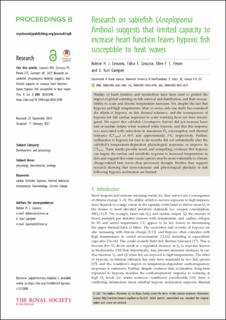| dc.contributor.author | Leeuwis, Robine Helena Jannigje | |
| dc.contributor.author | Zanuzzo, Fábio S. | |
| dc.contributor.author | Peroni, Ellen F. | |
| dc.contributor.author | Gamperl, Anthony Kurt | |
| dc.date.accessioned | 2023-03-06T14:11:53Z | |
| dc.date.available | 2023-03-06T14:11:53Z | |
| dc.date.created | 2023-01-20T12:11:55Z | |
| dc.date.issued | 2021 | |
| dc.identifier.issn | 0962-8452 | |
| dc.identifier.uri | https://hdl.handle.net/11250/3056145 | |
| dc.description.abstract | Studies of heart function and metabolism have been used to predict the impact of global warming on fish survival and distribution, and their susceptibility to acute and chronic temperature increases. Yet, despite the fact that hypoxia and high temperatures often co-occur, only one study has examined the effects of hypoxia on fish thermal tolerance, and the consequences of hypoxia for fish cardiac responses to acute warming have not been investigated. We report that sablefish (Anoplopoma fimbria) did not increase heart rate or cardiac output when warmed while hypoxic, and that this response was associated with reductions in maximum O2 consumption and thermal tolerance (CTmax) of 66% and approximately 3°C, respectively. Further, acclimation to hypoxia for four to six months did not substantially alter the sablefish's temperature-dependent physiological responses or improve its CTmax. These results provide novel, and compelling, evidence that hypoxia can impair the cardiac and metabolic response to increased temperatures in fish, and suggest that some coastal species may be more vulnerable to climate change-related heat waves than previously thought. Further, they support research showing that cross-tolerance and physiological plasticity in fish following hypoxia acclimation are limited. | en_US |
| dc.language.iso | eng | en_US |
| dc.publisher | The Royal Society Publishing | en_US |
| dc.rights | Navngivelse 4.0 Internasjonal | * |
| dc.rights.uri | http://creativecommons.org/licenses/by/4.0/deed.no | * |
| dc.title | Research on sablefish (Anoplopoma fimbria) suggests that limited capacity to increase heart function leaves hypoxic fish susceptible to heat waves | en_US |
| dc.title.alternative | Research on sablefish (Anoplopoma fimbria) suggests that limited capacity to increase heart function leaves hypoxic fish susceptible to heat waves | en_US |
| dc.type | Peer reviewed | en_US |
| dc.type | Journal article | en_US |
| dc.description.version | publishedVersion | en_US |
| dc.source.volume | 288 | en_US |
| dc.source.journal | Proceedings of the Royal Society of London. Biological Sciences | en_US |
| dc.source.issue | 1946 | en_US |
| dc.identifier.doi | 10.1098/rspb.2020.2340 | |
| dc.identifier.cristin | 2111487 | |
| cristin.ispublished | true | |
| cristin.fulltext | original | |
| cristin.qualitycode | 2 | |

